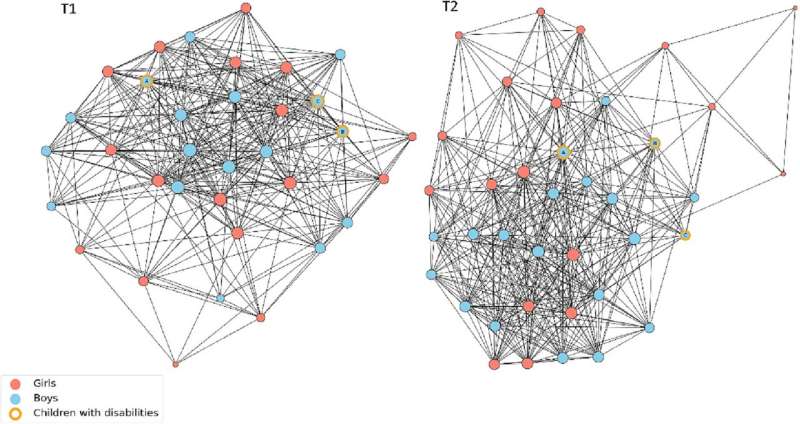This article has been reviewed according to Science X's editorial process and policies. Editors have highlighted the following attributes while ensuring the content's credibility:
fact-checked
trusted source
proofread
What happens on the schoolyard? Sensors on clothing reveal painful patterns

The design of school playgrounds partially influences whether children play together. This is particularly relevant for more vulnerable students, such as children with hearing impairments or autism. Researchers examined whether new play objects could break group patterns. However, sensors on the children's clothing revealed that these objects mainly reinforce the position of popular children.
"Some children already experience stomach pain on Sundays at the thought of going to school the next day," says psychologist Carolien Rieffe. She is the lead researcher of the Inclusive School Environment project, a long-term study into the physical and social accessibility of schoolyards.
Not all children feel at ease on the schoolyard and often find themselves standing alone during breaks. For instance, they may not be allowed to join in the games or struggle to keep up with the others. This is distressing because the school playground is a crucial place for their development.
Poor acoustics
The social climate, but also the physical environment, can sometimes be inhibiting, according to Rieffe. "For example, there is poor acoustics due to high walls surrounding the schoolyard, which reflect sounds. Or the playground is located next to a busy road, making conversations difficult to follow. This is particularly challenging for children with hearing impairments and children with autism, who are easily overstimulated," notes Rieffe.
Psychologist Adva Eichengreen is the lead author of the study published in the journal Child: Care, Health, and Development. She is partially deaf and knows from personal experience how challenging it can be to participate in a busy social environment.
New play objects on the schoolyard
New play interventions can lead to different group patterns, according to several international studies. Therefore, scientists conducted research at a Dutch primary school to examine whether temporary new play elements, such as car tires, boxes, household items, and barrels, could break the existing group dynamics.
Eichengreen says, "These are objects that do not have defined purposes and thus can stir children's imagination. Previous studies found that such loose-parts can increase co-operative play between children. We wanted to test whether these creative possibilities create new social opportunities for children who are often excluded."
To investigate this, the scientists used a novel method: they placed sensor clips on the children's clothing to clearly map all interactions. They complemented the sensor data with observations on the schoolyard. The interdisciplinary team, consisting of behavioral scientists, data scientists, and an architect, thus discovered various patterns
The rich get richer
The outcome was different than hoped for, says Rieffe and Eichengreen. The new play elements did cause more social interactions, but that was especially true for the children with already many play contacts. Rieffe says, "Probably because they already have a strong position in the group and are there first. The rich get richer. In contrast, the children with hearing impairment and autism got fewer interactions. So we have to look at how an intervention works out on an individual level."
The sensor clips provide valuable information, such as how the schoolyard is utilized, where children play most often, and which areas remain empty. "We report this back to the schools, so they have a better understanding of the accessibility of their schoolyard," says Rieffe.
The Ministry of Education, Culture, and Science (OCW) also shows great interest in the research. The scientists recently presented their findings at the ministry to the director of diversity and inclusion, who is also responsible for housing matters.
Eichengreen says, "We need to consider the social needs of children with disabilities when designing the structure of school playgrounds and the role of adults or older peers as social facilitators. At the end all children will benefit from these adaptations."
More information: Adva Eichengreen et al, The impact of loose‐parts‐play on schoolyard social participation of children with and without disabilities: A case study, Child: Care, Health and Development (2023). DOI: 10.1111/cch.13144




















